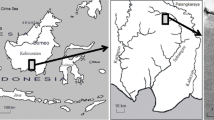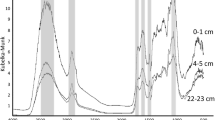Abstract
Peatlands contain enormous carbon stocks, but the stability of this carbon is variable. Peatlands can vary in tree cover from completely open to forested with associated differences in peat quality. Peat quality, or potential for mineralization, is a contributing factor affecting how the carbon balance of peatland ecosystems could change with climate or land use changes. We compared the peat quality of open peatlands dominated by Sphagnum mosses to forested, or silvic, peatlands dominated by black spruce and tamarack or northern white cedar to quantify the effects of different carbon sources on peat quality. We used Fourier-transform infrared spectrometry (FTIR) to analyze peat properties throughout the depth profile of 30 peat cores across the hemi-boreal Upper Great Lakes region. We found that tree cover was associated with differences in both surficial and deep peat quality. Silvic peat had lower peat quality than Sphagnum peat as shown by FTIR indices. Sphagnum peat also had significantly higher peat quality at the surface compared to at depth. However, silvic peat showed no significant difference with depth in any indices. Our results indicate that the dominant plant functional type is a strong driver of peat quality as we identified key differences between silvic and Sphagnum peatlands. These relatively local differences are similar in magnitude to those found across biomes comparing tropical swamps to boreal Sphagnum peatlands. This implies that the dominant plant functional type (e.g. tree, shrub, graminoid, or moss) may be more important to peat quality than species identity—or even latitude—in peatlands.





Similar content being viewed by others
Data Availability
The datasets generated during and/or analyzed during the current study are available from the Pangaea data repository (https://doi.org/10.1594/PANGAEA.942942). In the event that data is inaccessible from Pangaea, it will be made available by the corresponding author upon reasonable request.
References
Artz RRE, Chapman SJ, Jean Robertson AH, Potts JM, Laggoun-Défarge F et al (2008) FTIR spectroscopy can be used as a screening tool for organic matter quality in regenerating cutover peatlands. Soil Biol Biochem 40(2):515–527. doi: https://doi.org/10.1016/j.soilbio.2007.09.019
Blodau C, Roulet NT, Heitmann T, Stewart H, Beer J et al (2007) Belowground carbon turnover in a temperate ombrotrophic bog. Global Biogeochem Cycles 21(1):1–12. doi: https://doi.org/10.1029/2005GB002659
Bourgeau-Chavez LL, Endres S, Powell R, Battaglia MJ, Benscoter B et al (2017) Mapping boreal peatland ecosystem types from multitemporal radar and optical satellite imagery. Can J For Res 47(4):545–559. doi: https://doi.org/10.1139/cjfr-2016-0192
Bridgham SD, Richardson CJ (2003) Endogenous versus exogenous nutrient control over decomposition and mineralization in North Carolina peatlands. Biogeochemistry 65(2):151–178. doi: https://doi.org/10.1023/A:1026026212581
Bridgham SD, Updegraff K, Pastor J (1998) Carbon, nitrogen, and phosphorus mineralization in northern wetlands. Ecology 79(5):1545–1561. doi: https://doi.org/10.1890/0012-9658(1998)079[1545:CNAPMI]2.0.CO;2
Broder T, Blodau C, Biester H, Knorr KH (2012) Peat decomposition records in three pristine ombrotrophic bogs in southern Patagonia. Biogeosciences 9(4):1479–1491. doi: https://doi.org/10.5194/bg-9-1479-2012
Chimner RA, Ott CA, Perry CH, Kolka RK (2014) Developing and Evaluating Rapid Field Methods to Estimate Peat Carbon. Wetlands 34(6):1241–1246. doi: https://doi.org/10.1007/s13157-014-0574-6
Crum H, Buck WR (1988) A contribution to the Sphagnum (Sphagnaceae) flora of Paraguay. Brittonia 40(2):188–194
Durig DT, Esterle JS, Dickson TJ, Durig JR (1988) An investigation of the chemical variability of woody peat by FT-IR spectroscopy. Appl Spectrosc 42(7):1239–1244
Flanagan NE, Wang H, Winton S, Richardson CJ (2020) Low-severity fire as a mechanism of organic matter protection in global peatlands: Thermal alteration slows decomposition. Glob Chang Biol 26(March):3930–3946. doi: https://doi.org/10.1111/gcb.15102
Fujiwara A, Hirawake T, Suzuki K, Imai I, Saitoh SI (2014) Timing of sea ice retreat can alter phytoplankton community structure in the western Arctic Ocean. Biogeosciences 11(7):1705–1716. doi: https://doi.org/10.5194/bg-11-1705-2014
Goldstein A, Turner WR, Spawn SA, Anderson-teixeira KJ, Cook-patton S et al (2020) Protecting irrecoverable carbon in Earth’s ecosystems. Nat Clim Chang 10(April):287–295. doi: https://doi.org/10.1038/s41558-020-0738-8
Heller C, Ellerbrock RH, Roßkopf N, Klingenfuß C, Zeitz J (2015) Soil organic matter characterization of temperate peatland soil with FTIR-spectroscopy: Effects of mire type and drainage intensity. Eur J Soil Sci 66(5):847–858. doi: https://doi.org/10.1111/ejss.12279
Hodgkins SB, Richardson CJ, Dommain R, Wang H, Glaser PH et al (2018) Tropical peatland carbon storage linked to global latitudinal trends in peat recalcitrance. Nat Commun 9(1):1–13. doi: https://doi.org/10.1038/s41467-018-06050-2
Hribljan JA, Kane ES, Chimner RA (2017) Implications of Altered Hydrology for Substrate Quality and Trace Gas Production in a Poor Fen Peatland. Soil Sci Soc Am J 81(3):633. doi: https://doi.org/10.2136/sssaj2016.10.0322
Kalbitz K, Geyer W, Geyer S (1999) Spectroscopic properties of dissolved humic substances - A reflection of land use history in a fen area. Biogeochemistry 47(2):219–238. doi: https://doi.org/10.1023/A:1006134214244
Keller JK, Bauers AK, Bridgham SD, Kellogg LE, Iversen CM (2006) Nutrient control of microbial carbon cycling along an ombrotrophic-minerotrophic peatland gradient. J Geophys Res Biogeosciences 111(3):1–14. doi: https://doi.org/10.1029/2005JG000152
Keller JK, White JR, Bridgeham SD, Paster J (2004) Climate change effects on carbon and nitrogen mineralization in peatlands through changes in soil quality. Glob Chang Biol 1053–1064. doi: https://doi.org/10.1111/j.1365-2486.2004.00785.x
Kolka R, Bridgham SD, Ping CL (2016) Soils of peatlands: histosols and gelisols. In: Vepraskas MJ, Craft CL (eds) Wetlands soils: genesis, hydrology, landscapes and classification. Press/Lewis Publishing, Boca Raton, FL, pp 277–309
Kost MA, Albert DA, Cohen JG, Slaughter BS, Schillo RK et al (2007) Natural Communities of Michigan: Classification and Description.Michigan Nat. Featur. Invent. Rep. No.2007-21. https://mnfi.anr.msu.edu/communities/community.cfm?id=10652 (accessed 20 September 2016)
Laiho R (2006) Decomposition in peatlands: Reconciling seemingly contrasting results on the impacts of lowered water levels. Soil Biol Biochem 38(8):2011–2024. doi: https://doi.org/10.1016/j.soilbio.2006.02.017
Langor DW, Cameron EK, Macquarrie CJK, Mcbeath A, Mcclay A et al (2014) Non-native species in Canada’s boreal zone: diversity, impacts, and risk. Environ Rev 22(4):372–420
Nichols JE, Peteet DM (2019) Rapid expansion of northern peatlands and doubled estimate of carbon storage. Nat Geosci 12(November):917–922. doi: https://doi.org/10.1038/s41561-019-0454-z
Normand AE, Turner BL, Lamit LJ, Smith AN, Baiser B et al (2021) Organic Matter Chemistry Drives Carbon Dioxide Production of Peatlands. Geophys Res Lett 48(18):1–9. doi: https://doi.org/10.1029/2021GL093392
Environmental Protection US, Level III, and IV Ecoregions of the Continental United States (2013). https://www.epa.gov/eco-research/level-iii-and-iv-ecoregions-continental-united-stateshttp://www.epa.gov/wed/pages/ecoregions/level_iii_iv.html
Updegraff K, Bridgham SD, Pastor J, Weishampel P, Harth C (2001) Response of CO2 and CH4 emissions from peatlands to warming and water table manipulation. Ecol Appl 11(2):311–326. doi: https://doi.org/10.1890/1051-0761(2001)011[0311:rocace]2.0.co;2
Updegraff K, Pastor J, Bridgham SD, Johnston CA (1995) Environmental and Substrate Controls over Carbon and Nitrogen Mineralization in Northern Wetlands. Ecol Appl 5(1):151–163
Verbeke BA, Lamit LJ, Lilleskov EA, Hodgkins SB, Basiliko N et al (2022) Latitude, elevation, and mean annual temperature predict peat organic matter chemistry at a global scale. Global Biogeochem. Cycles: 1–17. doi: https://doi.org/10.1029/2021gb007057
Wiken E, Nava FJ, Griffith G (2011)North American Terrestrial Ecoregions—Level III. (April):1–149
Acknowledgements
We thank Sam Kurkowski and Andrew Robertson for all of their help with FTIR analyses, and Kate Heckman for her expertise. We additionally thank two anonymous reviewers for their constructive feedback, which contributed to greatly improving the manuscript.
Funding
We acknowledge the support and funding that we received from the USDA Forest Service, Hiawatha National Forest, and in-kind support from the USDA Forest Service, Northern Research Station. Funding from the National Institute of Food and Agriculture, USDA, McIntire-Stennis program, MTU graduate school, and the Ecosystem Science Center (MTU) also supported this study.
Author information
Authors and Affiliations
Contributions
All authors contributed to the conception of this study. Rodney Chimner and Evan Kane funded the study. Dominic Uhelski led material preparation, data collection, and analysis. Dominic Uhelski wrote the first draft, all authors contributed to editing previous drafts of the manuscript. All authors read and approved the final manuscript.
Corresponding author
Ethics declarations
Competing Interests:
The authors have no relevant financial or non-financial interests to disclose.
Additional information
Publisher’s Note
Springer Nature remains neutral with regard to jurisdictional claims in published maps and institutional affiliations.
Rights and permissions
About this article
Cite this article
Uhelski, D.M., Kane, E.S. & Chimner, R.A. Plant functional types drive Peat Quality differences. Wetlands 42, 51 (2022). https://doi.org/10.1007/s13157-022-01572-4
Received:
Revised:
Accepted:
Published:
DOI: https://doi.org/10.1007/s13157-022-01572-4




